Tyrosine Kinase
- IGFBR(1)
- Bcr-Abl(65)
- Ack1(2)
- Axl(6)
- ALK(54)
- BMX Kinase(3)
- Broad Spectrum Protein Kinase Inhibitor(10)
- c-FMS(33)
- c-Kit(56)
- c-MET(81)
- c-RET(0)
- CSF-1R(3)
- DDR1/DDR2 Receptor(1)
- EGFR(229)
- EphB4(1)
- FAK(33)
- FGFR(87)
- FLT3(85)
- HER2(12)
- IGF1R(30)
- Insulin Receptor(41)
- IRAK(25)
- ITK(10)
- Lck(1)
- LRRK2(22)
- PDGFR(93)
- PTKs/RTKs(3)
- Pyk2(6)
- ROR(38)
- Spleen Tyrosine Kinase (Syk)(31)
- Src(90)
- Tie-2 (3)
- Trk(35)
- VEGFR(169)
- Kinase(0)
- Discoidin Domain Receptor(14)
- DYRK(26)
- Ephrin Receptor(12)
- ROS(14)
- RET(28)
- TAM Receptor(28)
Products for Tyrosine Kinase
- Cat.No. Nombre del producto Información
-
GC13833
BMS-794833
BMS-794833 es un inhibidor de VEGFR2 y Met extraÍdo de la patente WO2009094417, compuesto ejemplo 1; tiene IC50 de 15 y 1,7 nM, respectivamente.

-
GC17772
BMS-817378
Potent ATP competitive inhibitor of Met/VEGFR2

-
GC11063
BMX-IN-1
BMX Inhibitor 1
A selective BMX and BTK inhibitor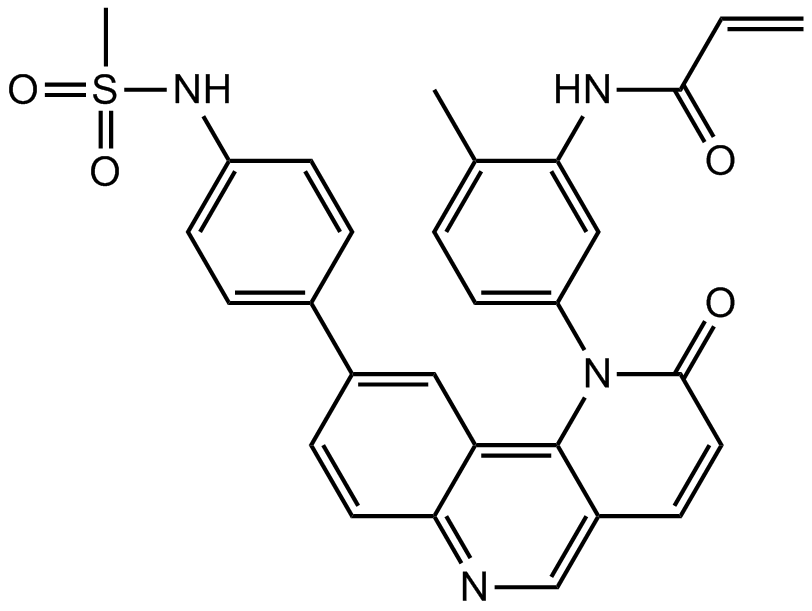
-
GC13343
Bosutinib (SKI-606)
SKI 606
Bosutinib (SKI-606) es un inhibidor oral de la tirosina quinasa Src/Abl con IC50 de 1,2 nM y 1 nM, respectivamente.
-
GC68796
Bosutinib hydrate
SKI-606 hydrate
Bosutinib (hidrato) es un inhibidor de la tirosina quinasa Src/Abl oral, con IC50 de 1.2 nM y 1 nM, respectivamente.
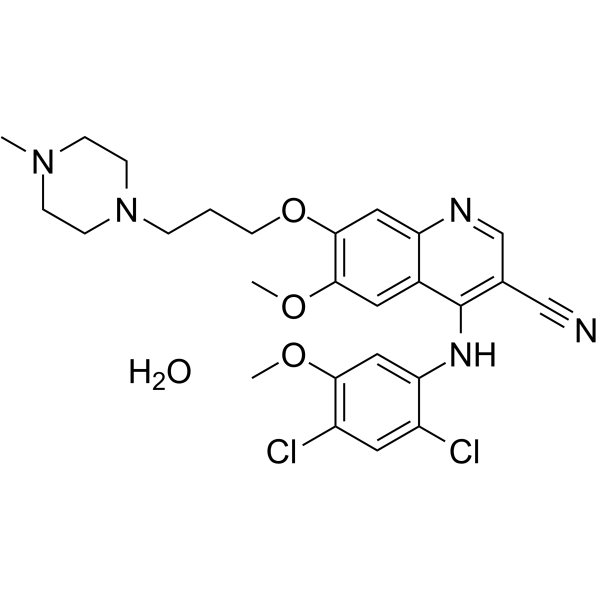
-
GC40080
Bosutinib-d8
SKI-606 D8
Bosutinib-d8 is intended for use as an internal standard for the quantification of bosutinib by GC- or LC-MS.
-
GC38894
Bozitinib
PLB-1001; CBT-101; Vebreltinib
Bozitinib (PLB-1001) es un inhibidor de la quinasa c-MET altamente selectivo con permeabilidad de la barrera hematoencefÁlica. Bozitinib (PLB-1001) es un inhibidor de molécula pequeÑa competitivo con ATP, se une al bolsillo de uniÓn a ATP convencional de la superfamilia de tirosina quinasas.
-
GC65966
BPI-9016M
BPI-9016M es un inhibidor dual potente, oralmente activo y selectivo de las tirosina quinasas c-Met y AXL. BPI-9016M suprime el crecimiento de células tumorales, la migraciÓn y la invasiÓn del adenocarcinoma de pulmÓn.
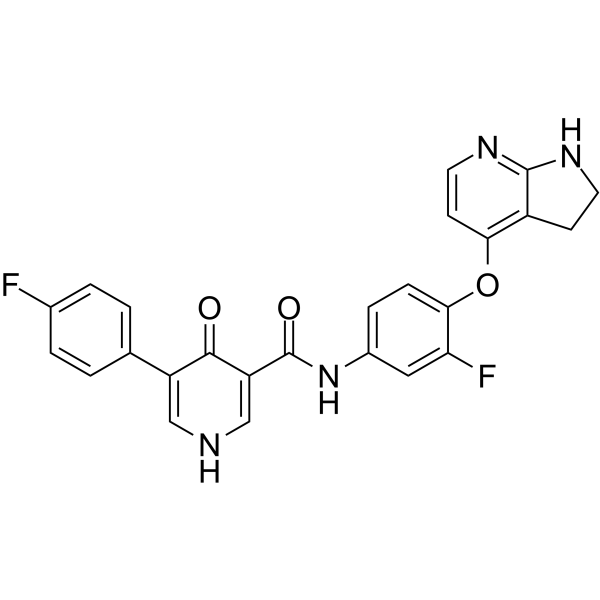
-
GC41631
BPIQ-I
PD 159121
BPIQ-I is a quinazoline that inhibits the tyrosine kinase activity of the epidermal growth factor receptor (IC50 = 0.025 nM).
-
GC19080
BPR1J-097
BPR1J-097 es un nuevo y potente inhibidor de FLT3 con una IC50 de 11nM.

-
GC35544
BPR1J-097 Hydrochloride
El clorhidrato BPR1J-097 es un nuevo y potente inhibidor de FLT3 con un IC50 de 11nM.
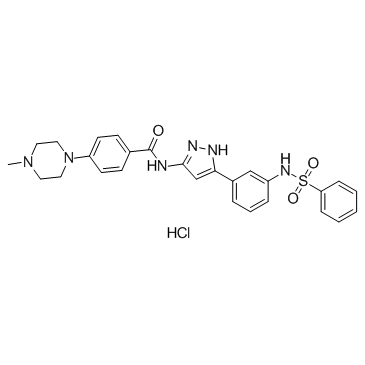
-
GC35545
BPR1K871
DBPR114
BPR1K871 es un inhibidor dual potente y selectivo de FLT3/AURKA con IC50 de 19 nM y 22 nM para FLT3 y AURKA, respectivamente, que actÚa como candidato de desarrollo preclÍnico para la terapia contra el cÁncer.
-
GC18718
bpV(pic) (potassium hydrate)
Bisperoxovanadium(pic)
bpV(pic) is a bisperoxovanadium (bpV) compound that inhibits several different protein tyrosine phosphatases (PTPs), with selectivity for PTEN (IC50 = 31 nM).
-
GC42972
Brain-Derived Acidic Fibroblast Growth Factor (1-11) (bovine) (trifluoroacetate salt)
Brain-derived aFGF (1-11)
Brain-derived acidic fibroblast growth factor (brain-derived aFGF) (1-11) is a peptide fragment of brain-derived aFGF.
-
GC19084
Brigatinib
Brigatinib
Brigatinib (AP-26113) es un inhibidor de ALK muy potente y selectivo, con una IC50 de 0,6 nM.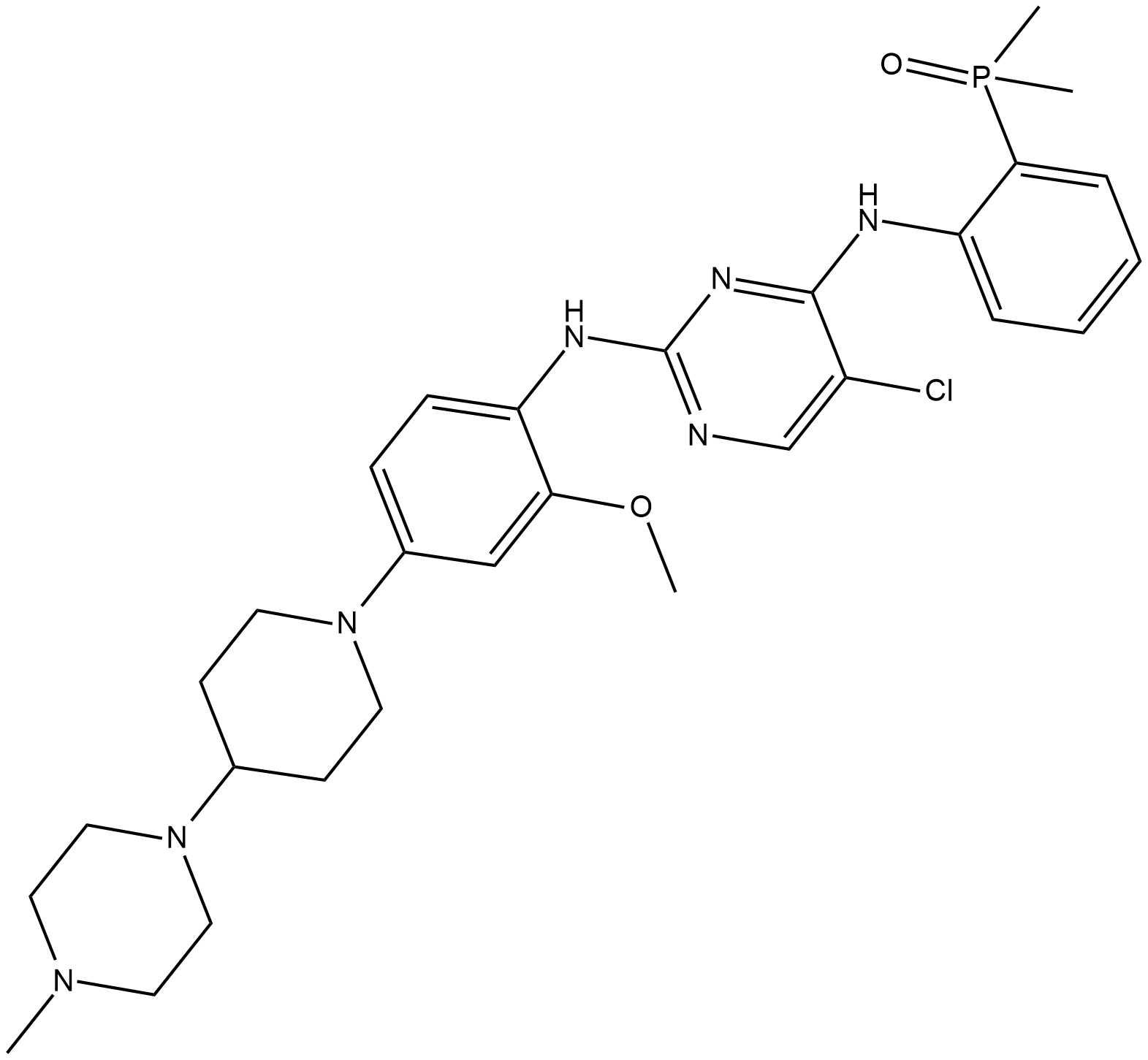
-
GC11692
Brivanib (BMS-540215)
BMS 540215
Brivanib (BMS-540215) (BMS-540215) es un inhibidor competitivo de ATP frente a VEGFR2 con una IC50 de 25 nM y tiene una potencia moderada frente a VEGFR-1 y FGFR-1, pero >240 veces frente a PDGFR-β.
-
GC14238
Brivanib Alaninate (BMS-582664)
BMS 582664
El alaninato de brivanib (BMS-582664) es un inhibidor competitivo de ATP frente a VEGFR2 con una IC50 de 25 nM; tiene una potencia moderada contra VEGFR-1 y FGFR-1, pero mÁs de 240 veces contra PDGFRβ.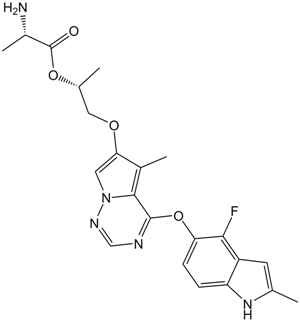
-
GC34509
BT-13
BT-13 es un potente y selectivo agonista de RET del receptor del factor neurotrÓfico derivado de la lÍnea de células gliales (GDNF) independientemente de las GFL, que promueve el crecimiento de neuritas de las neuronas sensoriales in vitro y atenÚa la neuropatÍa experimental en la rata .

-
GC68812
BT44
BT44 es un activador selectivo de RET. BT44 puede atravesar la barrera hematoencefálica y se puede utilizar para investigar enfermedades neurodegenerativas y diabetes.
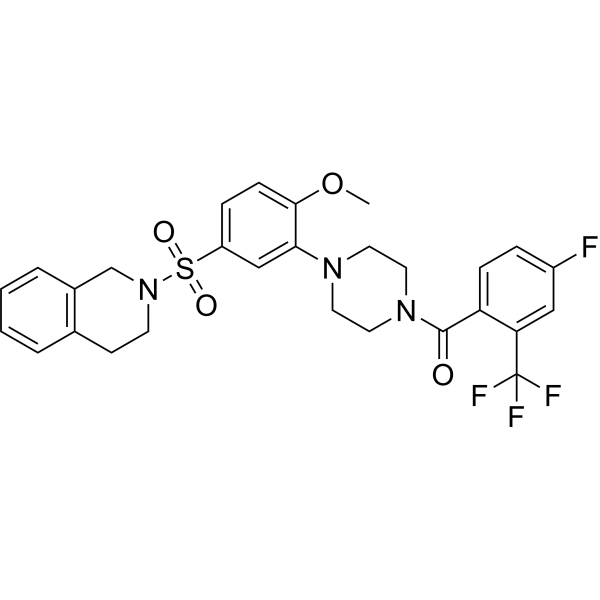
-
GC10944
Butein
2’,3,4,4’tetrahydroxy Chalcone
La buteÍna es un inhibidor de la PDE especÍfico de AMPc con una IC50 de 10,4 μM para la PDE4. La buteÍna es un inhibidor especÍfico de la proteÍna tirosina quinasa con IC50 de 16 y 65 μM para EGFR y p60c-src en células HepG2. La buteÍna sensibiliza las células HeLa al cisplatino a través de las vÍas AKT y ERK/p38 MAPK al dirigirse a FoxO3a. Butein es un activador SIRT1 (STAC).
-
GC34529
c-Fms-IN-1
c-Fms-IN-1 es un inhibidor de la cinasa FMS con una IC50 de 0,0008 μM.

-
GC35663
c-Fms-IN-10
c-Fms-IN-10 es el derivado de tieno [3,2-d] pirimidina, un inhibidor de la quinasa de FMS (receptor del factor 1 estimulante de colonias, CSF-1R) con IC50 de 2 nM.

-
GC66028
c-Fms-IN-13
c-Fms-IN-13 (compuesto 14) es un potente inhibidor de la quinasa FMS con un valor IC50 de 17 nM. c-Fms-IN-13 se puede utilizar como agente antiinflamatorio.

-
GC35664
c-Fms-IN-3
c-Fms-IN-3 es un nuevo inhibidor de la quinasa c-Fms con potencial como agente antiinflamatorio y agente antirreumÁtico.

-
GC35665
c-Fms-IN-8
c-Fms-IN-8 (compuesto 4a) es un inhibidor de tipo II del receptor del factor 1 estimulador de colonias (CSF-1R, c-FMS), con una IC50 de 9,1 nM.

-
GC35666
c-Fms-IN-9
c-Fms-IN-9 es un inhibidor de c-FMS extraÍdo de la patente WO2014145023A1, Ejemplo compuesto 7. c-Fms-IN-9 inhibe la c-FMS quinasa no fosforilada (uFMS) y uKIT con IC50 de <0,01 μM y 0,1-1 μM, respectivamente.
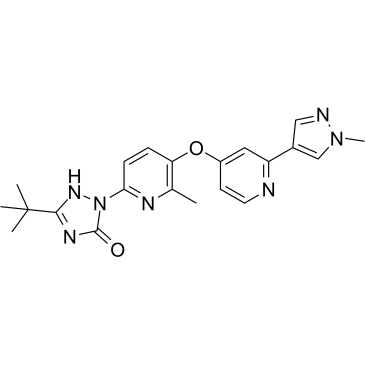
-
GC19106
c-Kit-IN-1
c-Kit-IN-1 is a potent inhibitor of c-Kit and c-Met with IC50s of <200 nM.
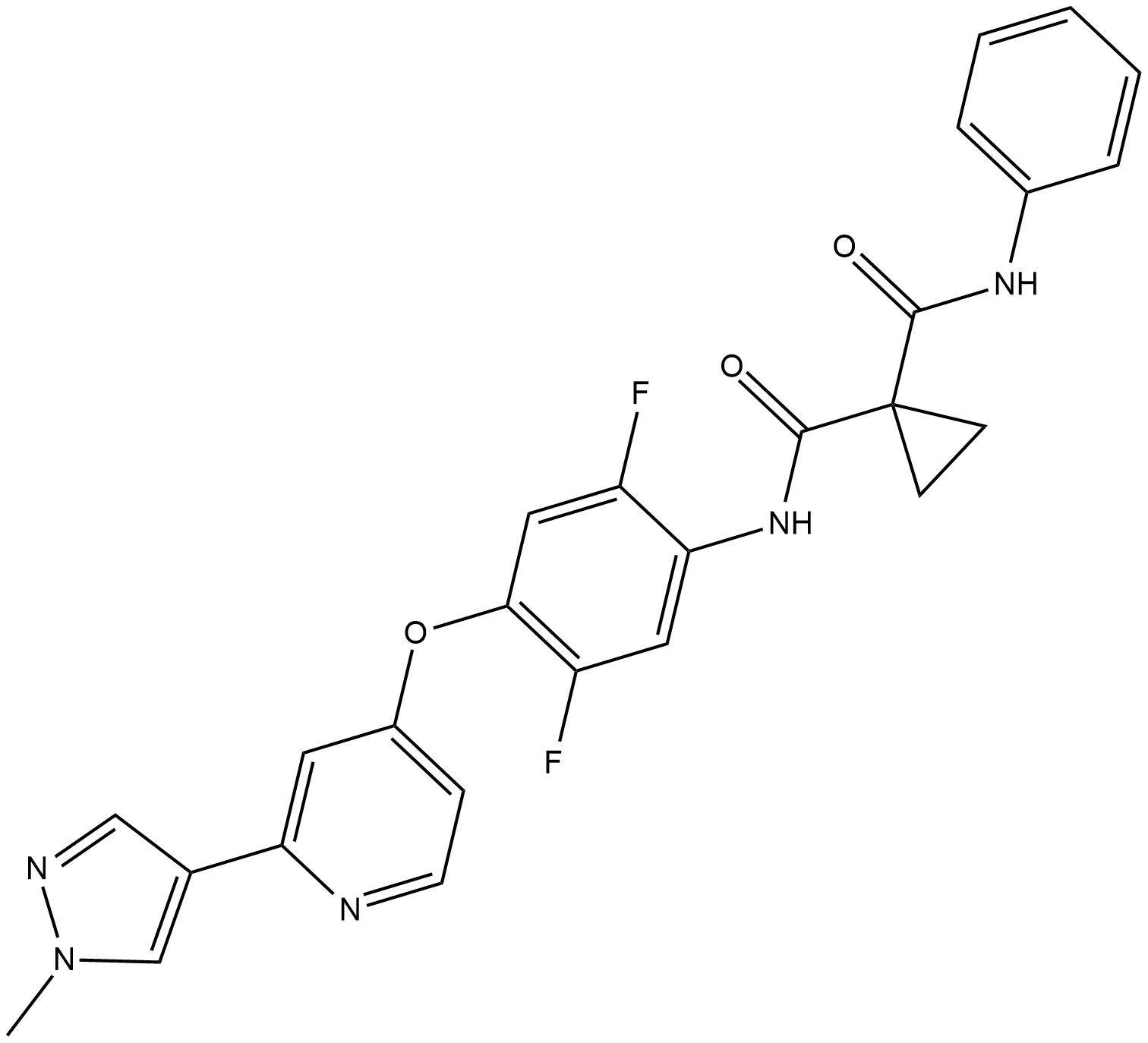
-
GC35705
c-Kit-IN-2
c-Kit-IN-2 es un inhibidor de c-KIT con un IC50 de 82 nM, muestra actividades antiproliferativas superiores contra las tres lÍneas celulares GIST, GIST882, GIST430 y GIST48, con GI50 de 3, 1 y 2 nM, respectivamente.

-
GC38595
c-Kit-IN-3

-
GC38756
c-Kit-IN-3 D-tartrate

-
GC38757
c-Kit-IN-3 hydrochloride

-
GC65948
c-Kit-IN-5-1
c-Kit-IN-5 es un potente inhibidor de c-Kit, con IC50 de 22 nM y 16 nM en ensayo de quinasa y ensayo celular, respectivamente. c-Kit-IN-5 muestra una selectividad de mÁs de 200 veces para c-Kit sobre KDR, p38, Lck y Src. c-Kit-IN-5 también exhibe propiedades farmacocinéticas deseables.

-
GC35716
c-Met inhibitor 1
El inhibidor 1 de c-Met es un inhibidor de la vÍa de seÑalizaciÓn del receptor de c-Met Útil para el tratamiento del cÁncer, incluidos el cÁncer gÁstrico, el glioblastoma y el pÁncreas.

-
GC35717
c-met-IN-1
c-met-IN-1 (compuesto 16) es un potente y selectivo inhibidor de c-Met, con IC50 de 1,1 nM, con actividad antitumoral.

-
GC33203
c-Met-IN-2
c-Met-IN-2 es un inhibidor de c-Met potente, selectivo y disponible por vÍa oral, con una IC50 de 0,6 nM, con actividad antitumoral.

-
GC32748
CA-4948
CA-4948 es un inhibidor selectivo, potente y oralmente activo de la quinasa 4 asociada al receptor de la interleucina-1 (IRAK4), extraÍdo de la patente WO2015104688 (ejemplo 1).

-
GC68820
Cabiralizumab
FPA 008; Anti-Human CSF1R Recombinant Antibody
Cabiralizumab (FPA 008) es un anticuerpo monoclonal (MAb) anti-CSF1R. Cabiralizumab puede mejorar la infiltración de células T y la respuesta inmune antitumoral de las células T. Cabiralizumab inhibe la activación de los osteoclastos y previene la pérdida ósea, lo que lo hace útil en el estudio de la artritis reumatoide (RA). Cabiralizumab se puede combinar con Nivolumab para investigar el cáncer de pulmón.
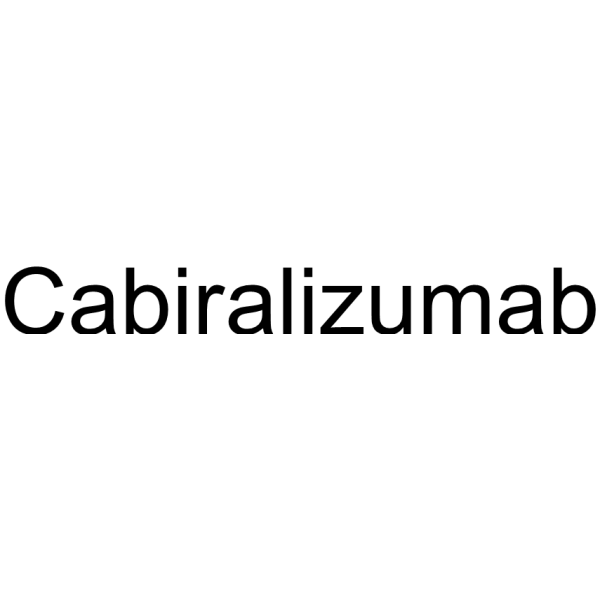
-
GC15779
Cabozantinib (XL184, BMS-907351)
BMS-907351, Cabozantinib
Cabozantinib (XL184, BMS-907351) es un inhibidor novedoso de MET y VEGFR2 que inhibe simultáneamente la metástasis, la angiogénesis y el crecimiento tumoral.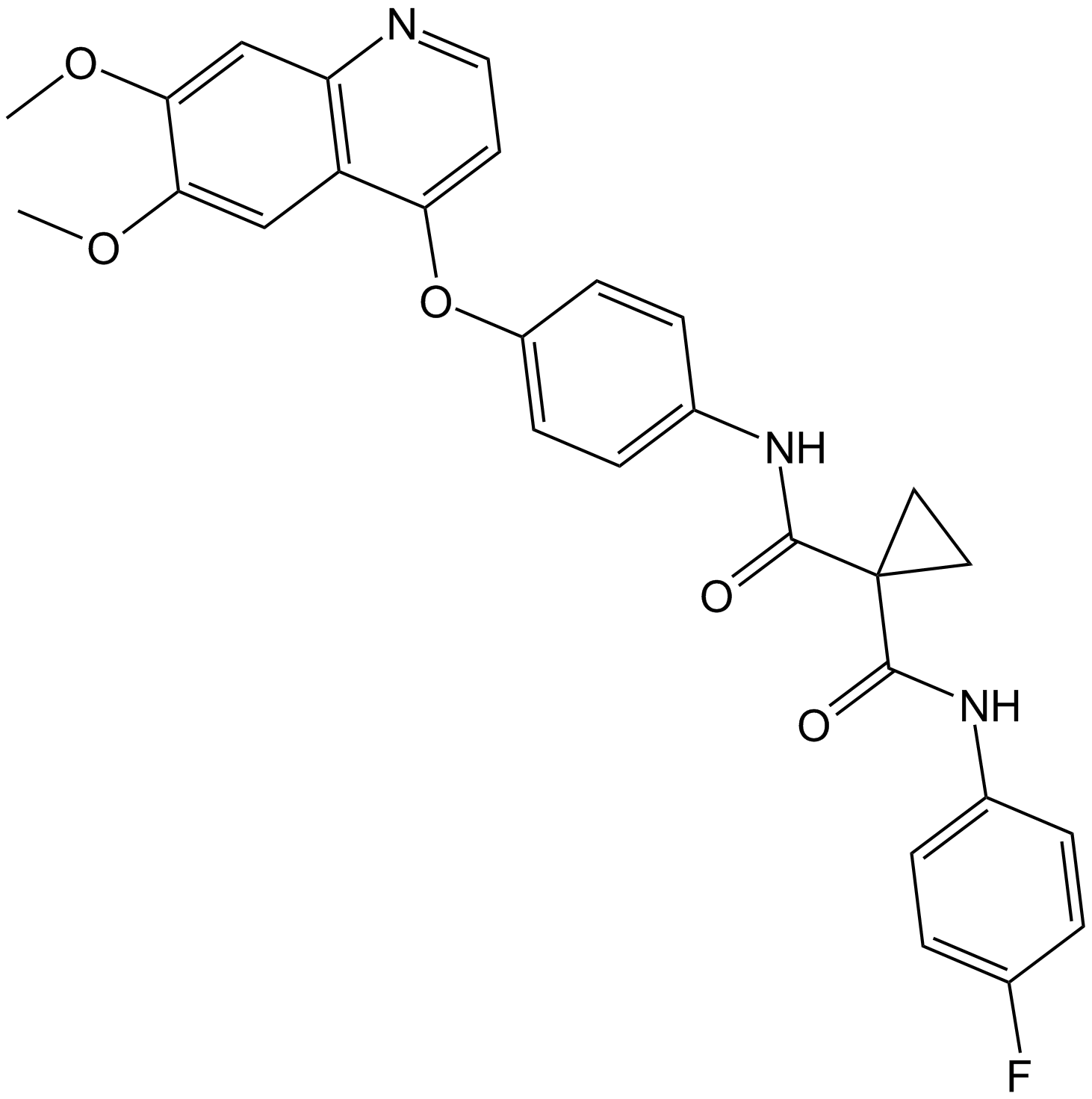
-
GC12531
Cabozantinib malate (XL184)
El malato de cabozantinib (XL184) (malato de XL184 S) es un potente inhibidor de múltiples receptores tirosina quinasas que inhibe VEGFR2, c-Met, Kit, Axl y Flt3 con IC50s de 0.035, 1.3, 4.6, 7 y 11.3 nM respectivamente.
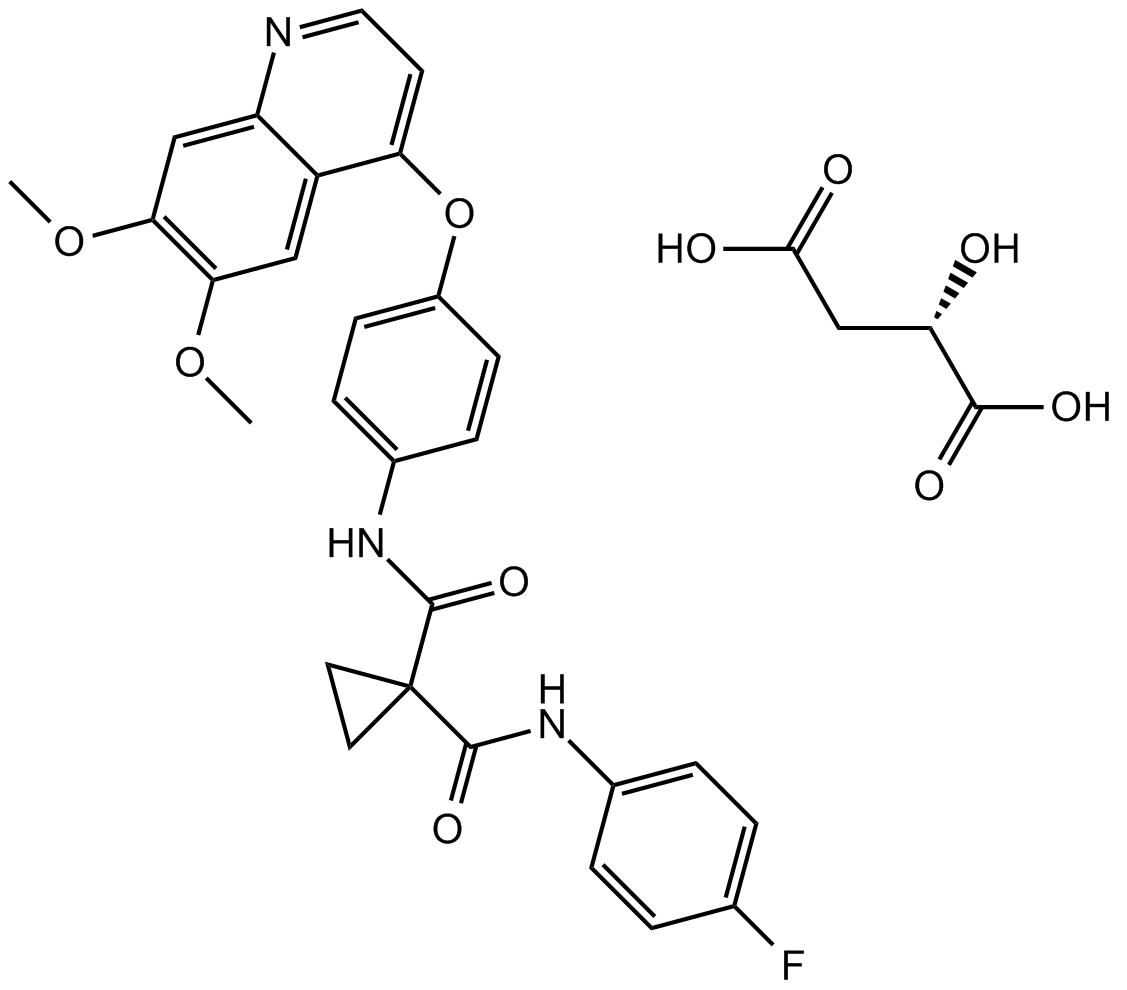
-
GC67948
Cabozantinib-d6
XL184-d6; BMS-907351-d6

-
GC50024
Caffeic acid-pYEEIE
El Ácido cafeico-pYEEIE, un inhibidor no fosfopeptÍdico, exhibe una potente afinidad de uniÓn por el dominio GST-Lck-SH2.
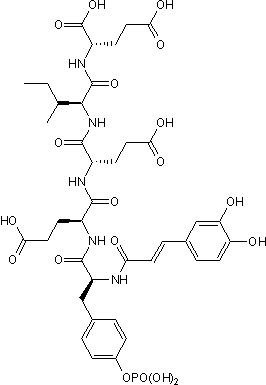
-
GC64564
Caffeic acid-pYEEIE TFA
El Ácido cafeico-pYEEIE TFA, un inhibidor no fosfopeptÍdico, exhibe una potente afinidad de uniÓn por el dominio GST-Lck-SH2.

-
GC12910
Canertinib (CI-1033)
Canertinib (CI-1033) (CI-1033;PD-183805) es un inhibidor de EGFR potente e irreversible; inhibe la autofosforilaciÓn de EGFR celular y ErbB2 con IC50 de 7,4 y 9 nM.

-
GC12087
Canertinib dihydrochloride
CI-1033, PD 183805
A pan-ErbB tyrosine kinase inhibitor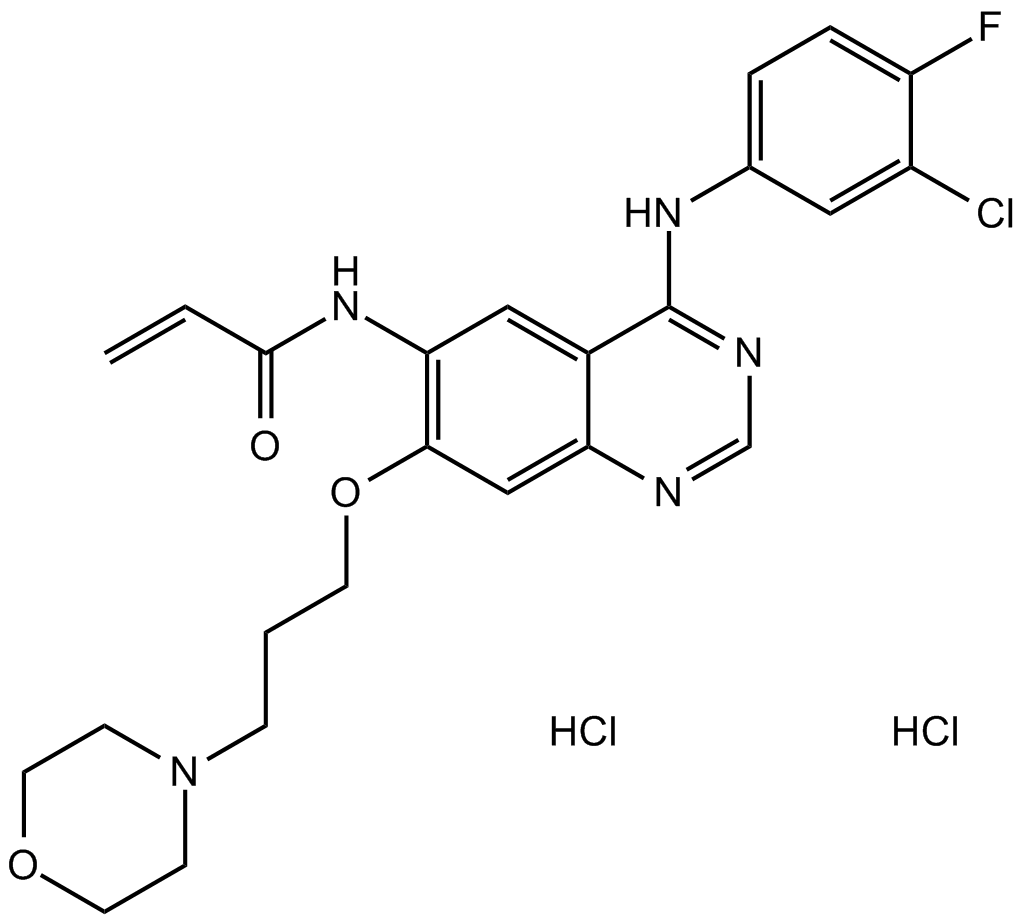
-
GC68828
Capmatinib dihydrochloride hydrate
Capmatinib (INC280; INCB28060) dihydrochloride hydrate es un inhibidor selectivo, competitivo con ATP y activo por vía oral de la quinasa c-Met (IC50=0.13 nM). Capmatinib dihydrochloride hydrate puede inhibir la fosforilación de c-MET, así como las proteínas efectores aguas abajo de la vía c-MET como ERK1/2, AKT, FAK, GAB1 y STAT3/5. Capmatinib dihydrochloride hydrate inhibe eficazmente la proliferación y migración celular dependiente de c-Met en células tumorales y también induce apoptosis celular. También ha demostrado actividad antitumoral en modelos murinos de cáncer. Capmatinib dihydrochloride hydrate se metaboliza principalmente por CYP3A4 y aldehído oxidasa.
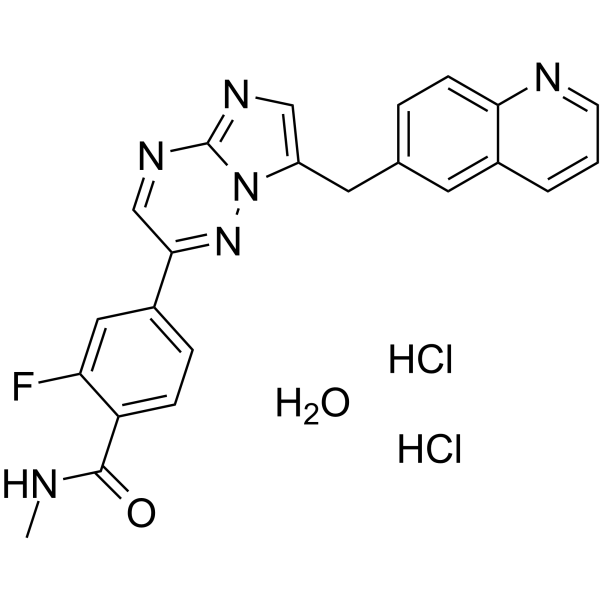
-
GC49433
Capsiate
El capsiato, como un anÁlogo de la capsaicina extraÍdo de una variedad no picante de pimiento rojo dulce CH-19, es un agonista activo por vÍa oral de TRPV1.

-
GC43198
CAY10717
CAY10717 is a multi-targeted kinase inhibitor that exhibits greater than 40% inhibition of 34 of 104 kinases in an enzymatic assay at a concentration of 100 nM.

-
GC49094
CAY10781
An NRP-1/VEGF-A interaction inhibitor

-
GC40054
CCT241161
CCT241161 es un inhibidor pan-RAF activo por vÍa oral con IC50 de 3, 6, 10, 15 y 30 nM para LCK, CRAF, SRC, V600E-BRAF y BRAF, respectivamente. CCT241161 muestra una buena actividad en los melanomas mutantes BRAF y NRAS. CCT241161 también exhibe actividad proliferativa de células anticancerÍgenas.

-
GC19092
CCT241736
CCT241736 es un inhibidor dual potente y biodisponible por vÍa oral de la quinasa Aurora y FLT3, que inhibe las quinasas Aurora (Aurora-A Kd, 7,5 nM, IC50, 38 nM; Aurora-B Kd, 48 nM), la quinasa FLT3 (Kd, 6,2 nM), y mutantes FLT3 que incluyen FLT3-ITD (Kd, 38 nM) y FLT3 (D835Y) (Kd, 14 nM).

-
GC32623
CE-245677
CE-245677 es un potente inhibidor reversible de las quinasas Tie2 y TrkA/B con una IC50 celular de 4,7 y 1 nM.

-
GC16421
Cediranib (AZD217)
AZD 2171, ZD 2171
Cediranib (AZD217) (AZD2171) es un inhibidor de la tirosina quinasa VEGFR disponible por vÍa oral muy potente con IC50 de <1, <3, 5, 5, 36, 2 nM para Flt1, KDR, Flt4, PDGFRα, PDGFRβ, c- Kit, respectivamente.
-
GC33004
Cediranib maleate (AZD-2171 maleate)
El maleato de cediranib (maleato de AZD-2171) (maleato de AZD-2171) es un inhibidor de VEGFR disponible por vÍa oral muy potente con IC50 de <1, <3, 5, 5, 36, 2 nM para Flt1, KDR, Flt4, PDGFRα PDGFRβ c-Kit, respectivamente.

-
GC63458
Cedirogant
ABBV-157
Cedirogant (ABBV-157) es un agonista inverso de RORγt activo por vÍa oral.
-
GC35651
Cenisertib
AS-703569; R-763
Cenisertib (AS-703569) es un inhibidor multicinasa competitivo con ATP que bloquea la actividad de Aurora-cinasa-A/B, ABL1, AKT, STAT5 y FLT3. Cenisertib induce importantes efectos inhibidores del crecimiento al bloquear la actividad de varios objetivos moleculares diferentes en los mastocitos neoplÁsicos (MC). Cenisertib inhibe el crecimiento tumoral en modelos de xenoinjerto de tumores de pÁncreas, mama, colon, ovario y pulmÓn y leucemia.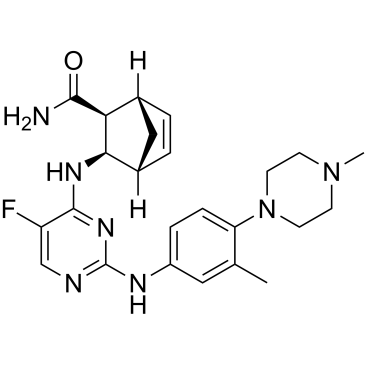
-
GC15145
CEP-28122
CEP-28122 es un inhibidor de ALK activo por vÍa oral muy potente y selectivo con IC50 de 1,9 ± 0,5 nM en un ensayo TRF basado en enzimas.
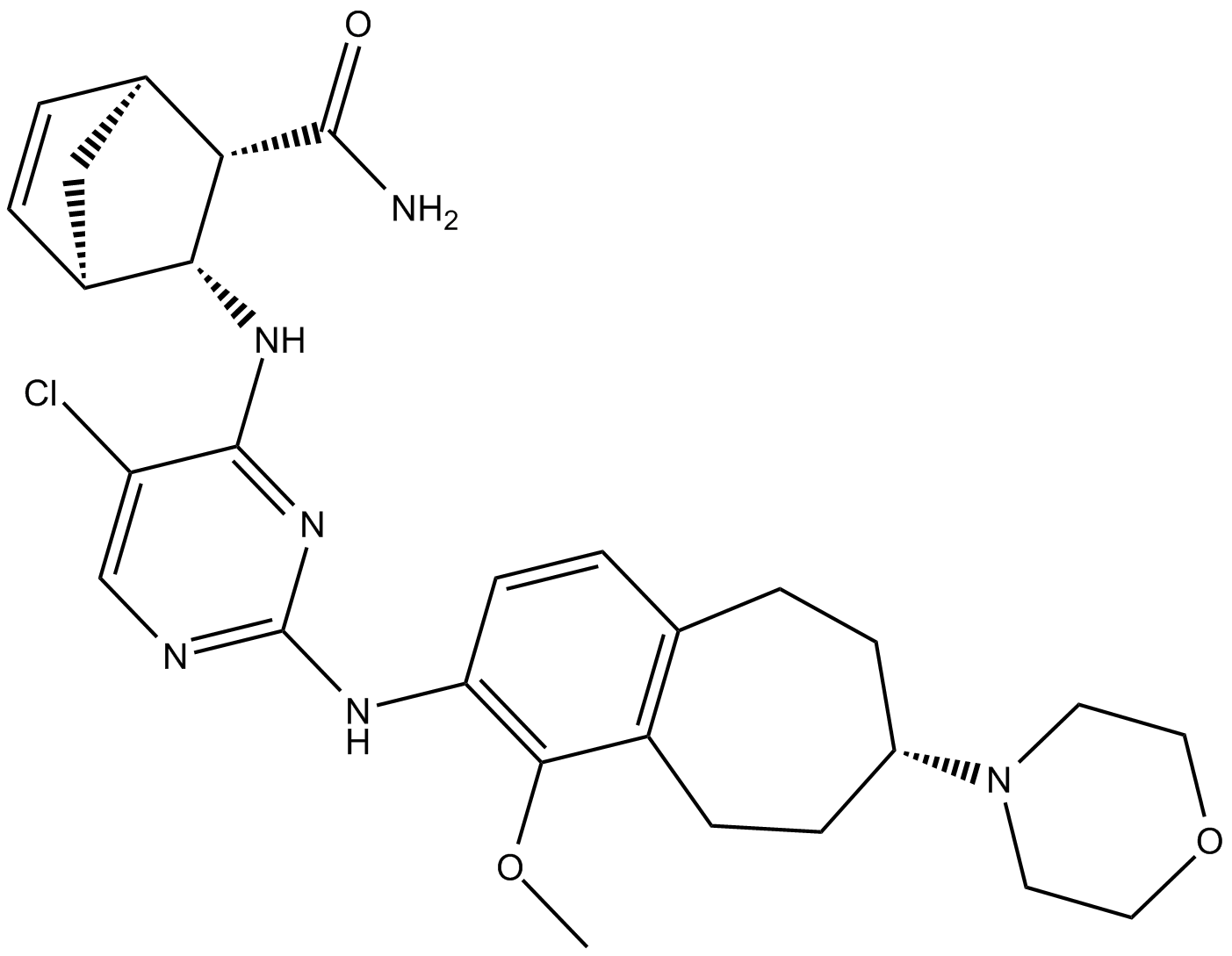
-
GC35652
CEP-28122 mesylate salt
La sal mesilato de CEP-28122, un derivado de diaminopirimidina, es un inhibidor de ALK potente, selectivo y biodisponible por vÍa oral, con un valor IC50 de 1,9 nM para la actividad de la quinasa ALK recombinante. CEP-28122 tiene actividad antitumoral en modelos experimentales de cÁnceres humanos ALK positivos. La sal de mesilato CEP-28122 tiene una buena actividad farmacodinÁmica y farmacocinética.

-
GC15273
CEP-37440
CEP-37440 es un potente inhibidor dual de FAK/ALK activo por vÍa oral con valores IC50 de 2,3 nM y 3,5 nM para FAK y ALK, respectivamente. CEP-37440 disminuye la proliferaciÓn celular al bloquear la actividad quinasa de autofosforilaciÓn de FAK1 (Tyr 397).

-
GC19102
CEP-40783
RXDX-106
CEP-40783 es un inhibidor potente, selectivo y disponible por vÍa oral de AXL y c-Met con valores IC50 de 7 nM y 12 nM, respectivamente.
-
GC11209
Cerdulatinib (PRT062070)
PRT062070, PRT2070
Cerdulatinib (PRT062070) (PRT062070) es un inhibidor selectivo de Tyk2 con una IC50 de 0,5 nM. Cerdulatinib (PRT062070) (PRT062070) también es un inhibidor dual de JAK y SYK con IC50 de 12, 6, 8 y 32 para JAK1, 2, 3 y SYK, respectivamente.
-
GC45789
Ceritinib-d7
LDK 378-d7
Ceritinib-d7 (LDK378 D7) es un ceritinib marcado con deuterio.
-
GC34217
Cetuximab (C225)
C225
Cetuximab (C225) es un anticuerpo monoclonal quimérico generado a partir de la fusión de la región variable del anticuerpo monoclonal murino anti-EGFR M225 y la región constante de la IgG1 humana.
-
GC63429
Cevidoplenib
SKI-O-703
Cevidoplenib es un inhibidor disponible por vÍa oral de la tirosina quinasa del bazo (Syk), con posibles actividades antiinflamatorias e inmunomoduladoras.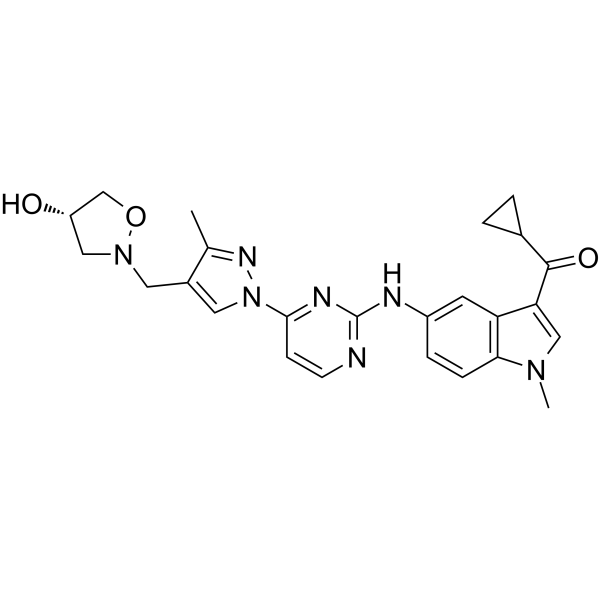
-
GC63455
Cevidoplenib dimesylate
SKI-O-703 dimesylate
Cevidoplenib es un inhibidor disponible por vÍa oral de la tirosina quinasa del bazo (Syk), con posibles actividades antiinflamatorias e inmunomoduladoras.
-
GC34528
cFMS Receptor Inhibitor II
cFMS Receptor Inhibitor II es un inhibidor de la quinasa CSF1R.

-
GC65976
cFMS Receptor Inhibitor IV
El inhibidor IV del receptor de cFMS (Compuesto 42) es un potente inhibidor de cFMS con una IC50 de 0,017 μM.
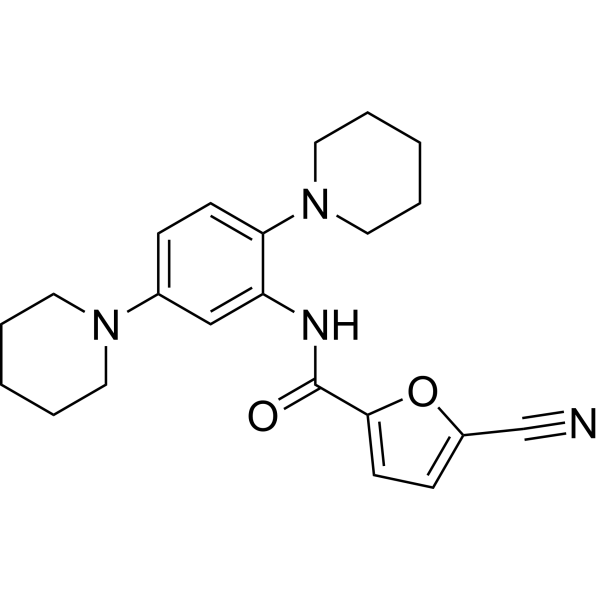
-
GC31726
cFMS-IN-2
cFMS-IN-2 es un inhibidor de la cinasa FMS con una IC50 de 0,024 μM.
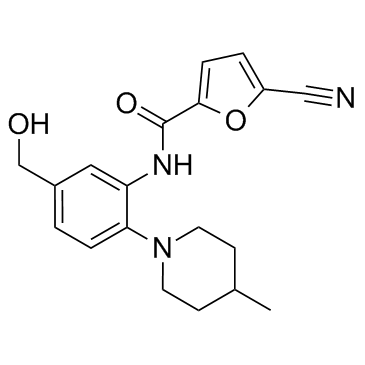
-
GC33064
CG-806 (Luxeptinib)
CG-806
CG-806 (Luxeptinib) (CG-806) es un inhibidor pan-FLT3/pan-BTK activo por vÍa oral, reversible, primero en su clase, no covalente y potente. CG-806 (Luxeptinib) induce la detenciÓn del ciclo celular, la apoptosis o la autofagia en células de leucemia mieloide aguda.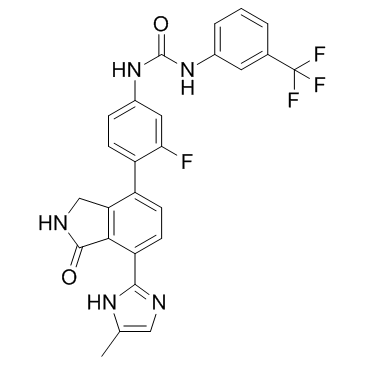
-
GC15950
CGP 52411
CGP 52411, 4,5-Dianilinophthalimide
CGP 52411 (DAPH) es un inhibidor de EGFR altamente selectivo, potente, activo por vía oral y competitivo con ATP con una IC50 de 0,3 μM.
-
GC18438
CGP 77675
CGP 77675 es un inhibidor potente y activo por vía oral de las quinasas de la familia Src. CGP 77675 inhibe la fosforilación de sustratos peptídicos y la autofosforilación de Src purificada (IC50 de 5-20 y 40 nM, respectivamente), y también inhibe Src, EGFR, KDR, v-Abl y Lck con IC50 de 5-20, 40, 20 , 150, 1000, 310 y 290 nM, respectivamente. Actividad anticancerígena.

-
GC48992
CGP 77675 (hydrate)
An inhibitor of Src family kinases

-
GC14650
CGP60474
A CDK inhibitor

-
GC10759
CH5183284 (Debio-1347)
Debio 1347
CH5183284 (Debio-1347) (Debio 1347) es un inhibidor de FGFR selectivo y disponible por vÍa oral con IC50 de 9,3, 7,6 y 22 nM para FGFR1, FGFR2, FGFR3 y FGFR4, respectivamente.
-
GC16025
CH5424802
Alectinib, RO5424802
CH5424802 (CH5424802) es un inhibidor de ALK potente, selectivo y disponible por vÍa oral con una IC50 de 1,9 nM y un valor de Kd de 2,4 nM (de manera competitiva con ATP), y también inhibe ALK F1174L y ALK R1275Q con IC50 de 1 nM y 3,5 nM, respectivamente. CH5424802 demuestra una penetraciÓn eficaz en el sistema nervioso central (SNC).
-
GC33112
CH7057288
CH7057288 es un inhibidor potente y selectivo de TRK.
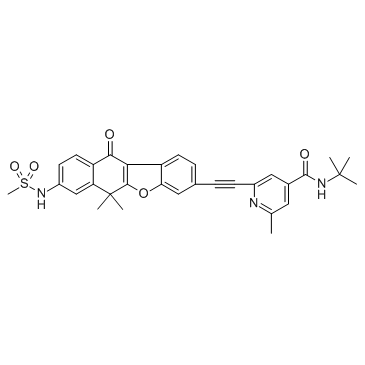
-
GC25219
CH7233163
CH7233163 is a non-covalent ATP competitive inhibitor of EGFR-tyrosine kinase with antitumor activities against tumor with EGFR-Del19/T790M/C797S.

-
GC62145
Chiauranib
CS2164
Chiauranib (CS2164) es un inhibidor multidiana activo por vÍa oral contra la angiogénesis tumoral. Chiauranib inhibe potentemente las quinasas relacionadas con la angiogénesis (VEGFR1, VEGFR2, VEGFR3, PDGFRα y c-Kit), la quinasa relacionada con la mitosis Aurora B y la quinasa relacionada con la inflamaciÓn crÓnica CSF-1R, con valores de IC50 que oscilan entre 1 y 9 nM. Chiauranib tiene fuertes efectos anticancerÍgenos.
-
GC15739
CHIR-124
CHIR-124 es un inhibidor potente y selectivo de Chk1 con IC50 de 0,3 nM, y también se dirige potentemente a PDGFR y FLT3 con IC50 de 6,6 nM y 5,8 nM.
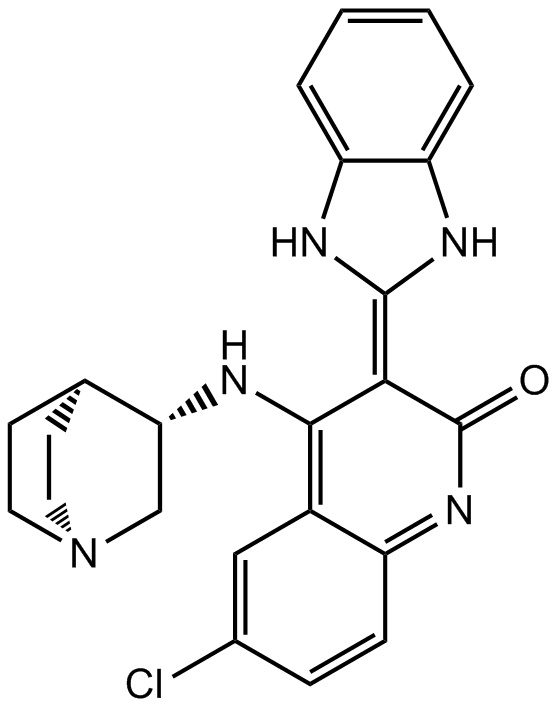
-
GC32979
Chloropyramine hydrochloride
El clorhidrato de cloropiramina es un antagonista del receptor H1 de histamina que también puede inhibir la funciÓn bioquÍmica de VEGFR-3 y FAK.

-
GC17294
CHMFL-ABL-053
CHMFL-ABL-053 (Compuesto 18a) es un inhibidor de la cinasa BCR-ABL, SRC y p38 potente, selectivo y disponible por vÍa oral con valores IC50 de 70, 90 y 62 nM contra ABL1, SRC y p38, respectivamente.

-
GC35682
CHMFL-ABL/KIT-155
CHMFL-ABL-KIT-155
CHMFL-ABL/KIT-155 (CHMFL-ABL-KIT-155; compuesto 34) es un inhibidor dual de la cinasa ABL/c-KIT de tipo II altamente potente y activo por vÍa oral (CI50 de 46 nM y 75 nM, respectivamente), y también presenta actividades inhibitorias significativas para BLK (IC50=81 nM), CSF1R (IC50=227 nM), DDR1 (IC50=116 nM), DDR2 (IC50=325 nM), LCK (IC50=12 nM) y PDGFRβ (IC50= 80 nM) quinasas. CHMFL-ABL/KIT-155 (CHMFL-ABL-KIT-155) detiene la progresiÓn del ciclo celular e induce la apoptosis.
-
GC33020
CHMFL-BMX-078 (CHMFL-BMX 078)
CHMFL-BMX 078
CHMFL-BMX-078 (CHMFL-BMX 078) es un inhibidor irreversible de la cinasa BMX de tipo II muy potente y selectivo con una IC50 de 11 nM.
-
GC35684
CHMFL-EGFR-202
CHMFL-EGFR-202 es un inhibidor potente e irreversible de la quinasa mutante del receptor del factor de crecimiento epidérmico (EGFR), con IC50 de 5,3 nM y 8,3 nM para las quinasas EGFR T790M y WT EGFR mutantes resistentes a los medicamentos, respectivamente. CHMFL-EGFR-202 muestra una selectividad de ~10 veces por EGFR L858R/T790M frente al EGFR de tipo salvaje en las células. CHMFL-EGFR-202 adopta una conformaciÓn de uniÓn inactiva covalente \CHMFL-EGFR-202 adopts a covalent "DFG-in-C-helix-out" inactive binding conformation with EGFR, with strong antiproliferative effects against EGFR mutant-driven nonsmall-cell lung cancer (NSCLC) cell lines.en_es_2021q4.md
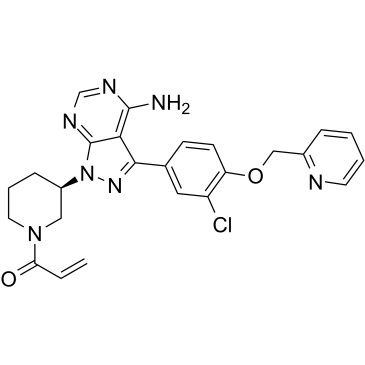
-
GC35685
CHMFL-KIT-033
CHMFL-KIT-033 es un inhibidor potente y selectivo del mutante c-KIT T670I para tumores del estroma gastrointestinal (GIST), con una IC50 de 0,045 μM.

-
GN10327
Chrysophanol
Chrysophanic Acid, NSC 37132, NSC 646567, Turkey Rhubarb

-
GC43268
Cinnamtannin B-1
LDN-0022358
Cinnamtannin B-1 es una proantocianidina con mÚltiples funciones biolÓgicas, incluidos los efectos antioxidantes y la inhibiciÓn de la producciÓn de especies reactivas de oxÍgeno (ROS).
-
GC32713
Cintirorgon (LYC-55716)
LYC-55716
Cintirorgon (LYC-55716) (LYC-55716) es un RORγ de primera clase, selectivo y biodisponible por vÍa oral; agonista Cintirorgon (LYC-55716) (LYC-55716) modula la expresiÓn génica de RORγ expresando células inmunitarias de linfocitos T, lo que da como resultado una funciÓn efectora mejorada, asÍ como una disminuciÓn de la inmunosupresiÓn, lo que da como resultado una disminuciÓn del crecimiento tumoral y una mejor supervivencia.
-
GC39485
CK2/ERK8-IN-1
CK2/ERK8-IN-1 es un inhibidor dual de caseÍna quinasa 2 (CK2) (Ki de 0,25 μM) y ERK8 (MAPK15, ERK7) con IC50 de 0,50 μM. CK2/ERK8-IN-1 también se une a PIM1, HIPK2 (proteÍna quinasa 2 que interactÚa con el homeodominio) y DYRK1A con Kis de 8,65 μM, 15,25 μM y 11,9 μM, respectivamente. CK2/ERK8-IN-1 tiene eficacia proapoptÓtica.

-
GC17790
CL-387785 (EKI-785)
EKB-785, EKI-785, WAY-EKI-785
CL-387785 (EKI-785)(EKI785; WAY-EKI 785) es un inhibidor irreversible de EGFR con IC50 de 370 pM.
-
GC68888
CMX-2043
CMX-2043 es un nuevo análogo similar al ácido α-lipoico. CMX-2043 tiene propiedades antioxidantes y puede activar la quinasa del receptor de insulina, la quinasa soluble de tirosina y la fosforilación Akt. En el modelo de lesión por isquemia-reperfusión (IRI) en ratas, CMX-2043 muestra efectos protectores.
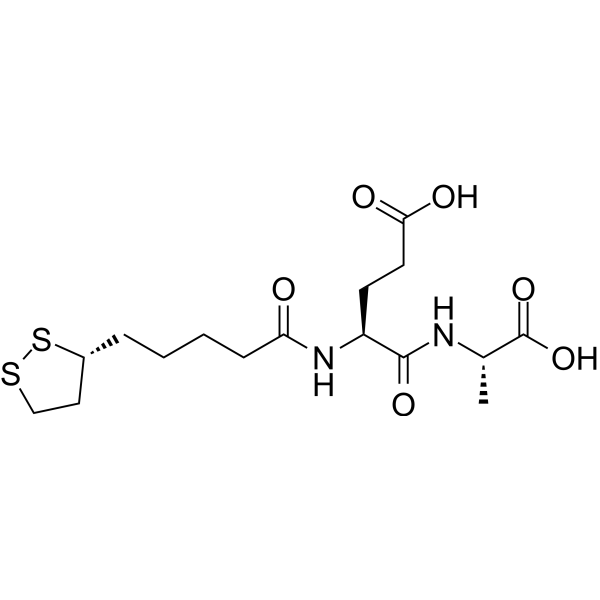
-
GC11264
CNX-2006
CNX-2006 es un inhibidor de EGFR irreversible y selectivo para mutantes con una IC50 por debajo de 20 nM para EGFRT790M.

-
GC14695
CO-1686 (AVL-301)
AVL-301;CNX-419; Rociletinib
A selective inhibitor of mutant EGFR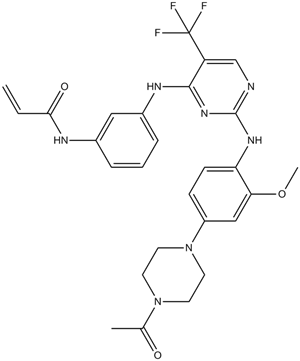
-
GC12837
Compound 56
A potent EGFR inhibitor
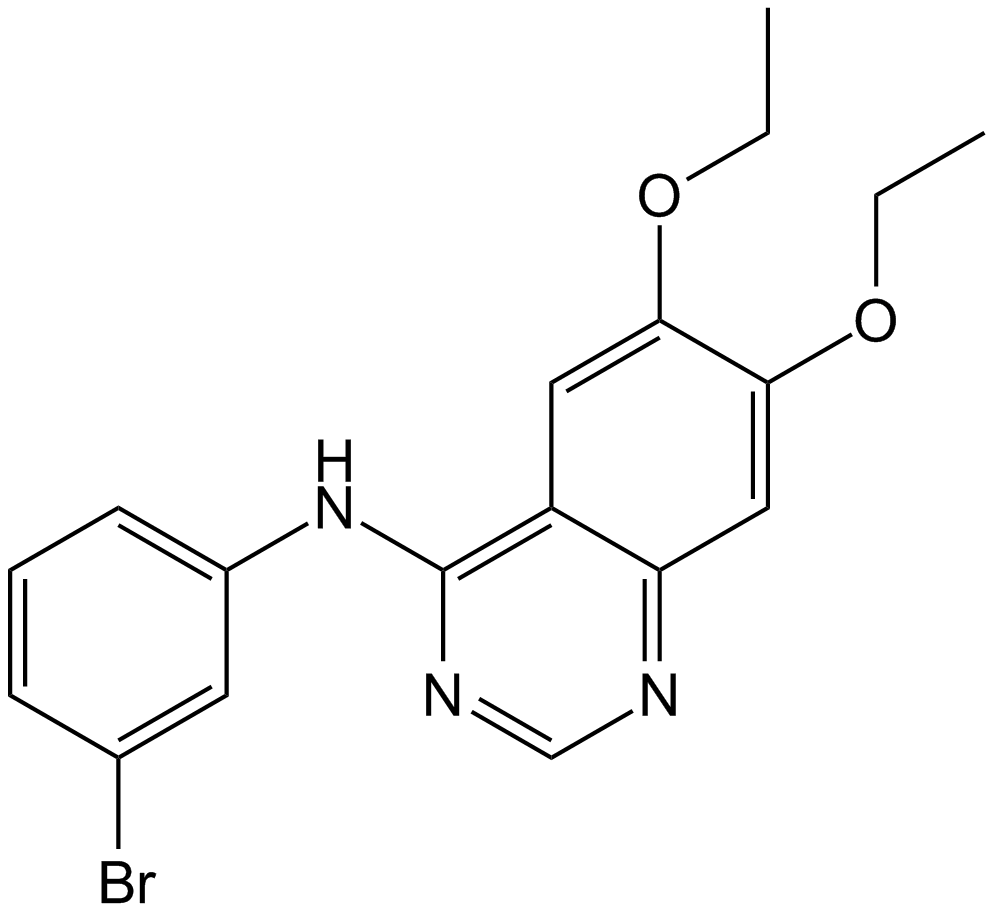
-
GC46123
Comprehensive Kinase Screening Library
For screening of a variety of kinase inhibitors

-
GC35728
Conteltinib
CT-707
Conteltinib (CT-707) es un inhibidor multicinasa que se dirige a FAK, ALK y Pyk2. Conteltinib ejerce un efecto inhibidor significativo sobre FAK con una IC50 de 1,6 nM.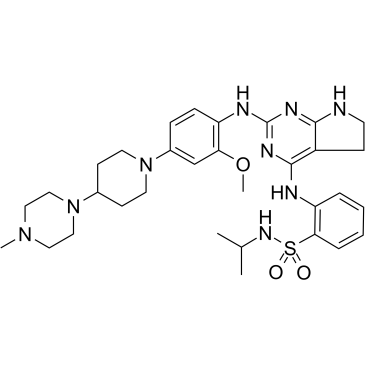
-
GC33352
CP-547632
CP-547632 es un potente inhibidor de las quinasas VEGFR-2 y FGF activo por vÍa oral, competitivo con ATP y con IC50 de 11 nM y 9 nM, respectivamente. CP-547632 es selectivo para VEGFR2 y bFGF sobre EGFR, PDGFRβ y tirosina quinasas (TK) relacionadas. CP-547632 tiene eficacia antitumoral.
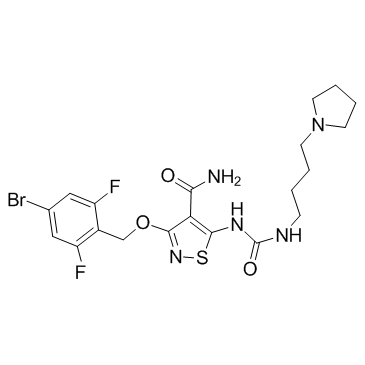
-
GC38575
CP-547632 hydrochloride
El clorhidrato de CP-547632 es un potente inhibidor de las quinasas VEGFR-2 y FGF activo por vÍa oral, competitivo con ATP y con IC50 de 11 nM y 9 nM, respectivamente. El clorhidrato de CP-547632 es selectivo para VEGFR2 y bFGF sobre EGFR, PDGFRβ y tirosina quinasas (TK) relacionadas. El clorhidrato de CP-547632 tiene eficacia antitumoral.

-
GC60726
CP-547632 TFA
CP-547632 TFA es un potente inhibidor de las quinasas VEGFR-2 y FGF activo por vÍa oral, competitivo con ATP y con IC50 de 11 nM y 9 nM, respectivamente. CP-547632 TFA es selectivo para VEGFR2 y bFGF sobre EGFR, PDGFRβ y tirosina quinasas (TK) relacionadas. CP-547632 TFA tiene eficacia antitumoral.

-
GC12980
CP-673451
CP-673451 es un inhibidor potente y selectivo de PDGFR con IC50 de 10 y 1 nM para PDGFRα y PDGFRβ, respectivamente.
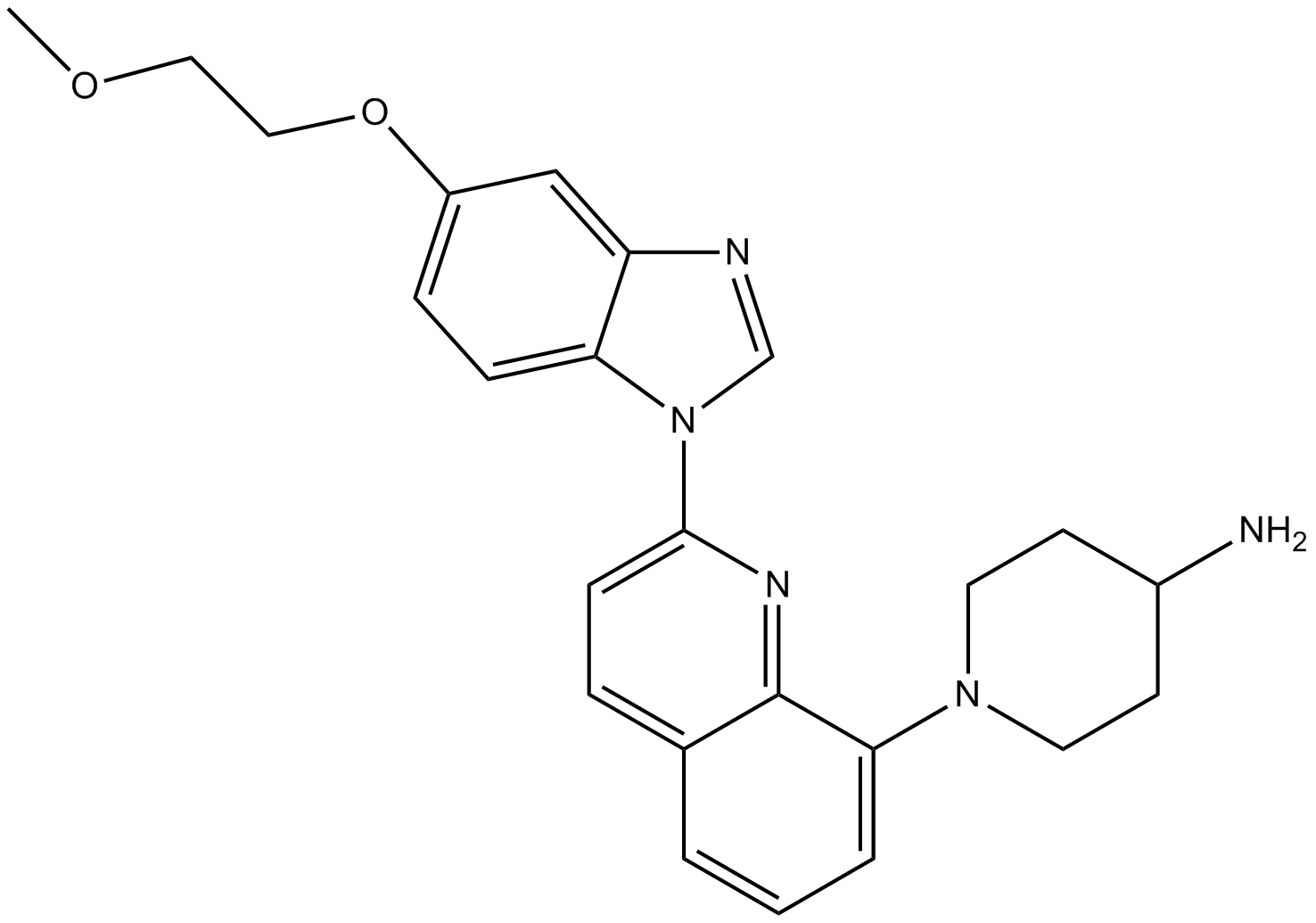
-
GC13091
CP-724714
CP-724714 es un inhibidor de la tirosina quinasa ErbB2 (HER2) potente, selectivo y activo por vÍa oral, con una IC50 de 10 nM. CP-724714 muestra una marcada selectividad frente a la quinasa EGFR (IC50=6400 nM). CP-724714 inhibe potentemente la autofosforilaciÓn del receptor ErbB2 en células intactas. Actividades antitumorales.



